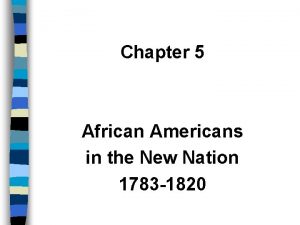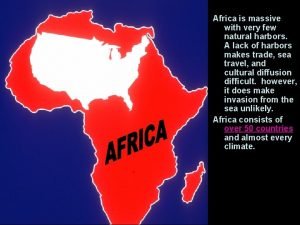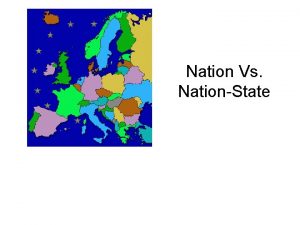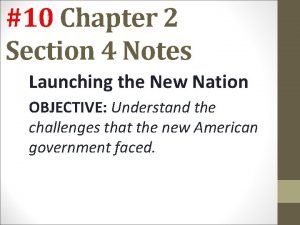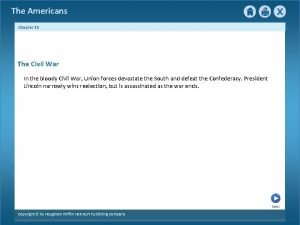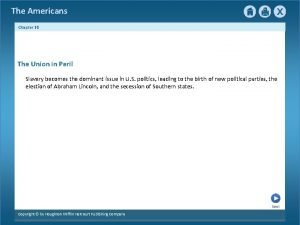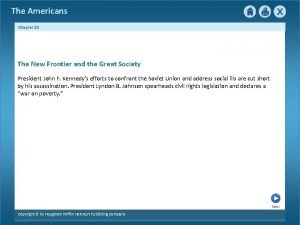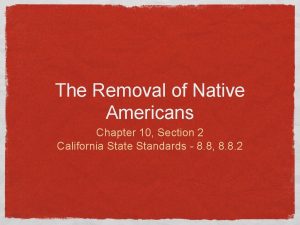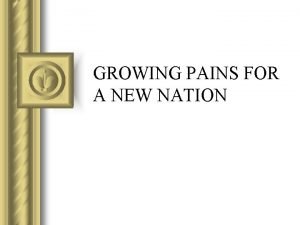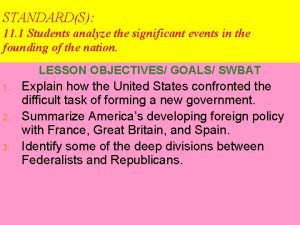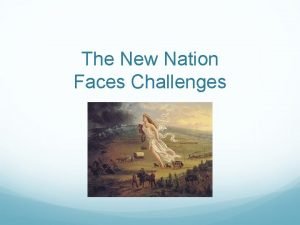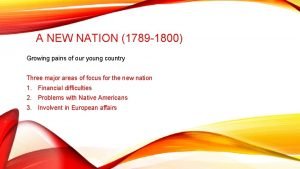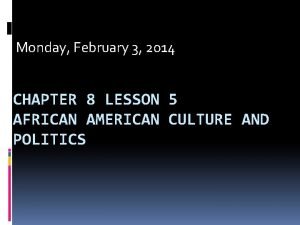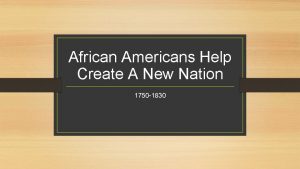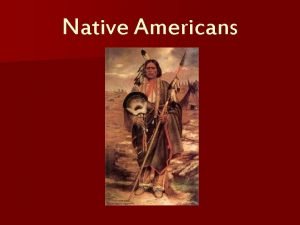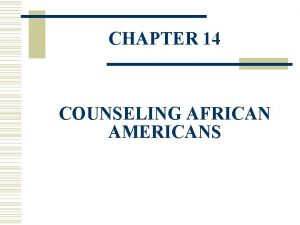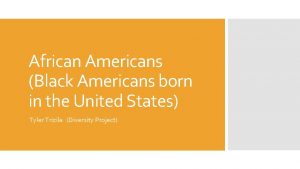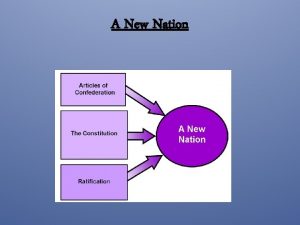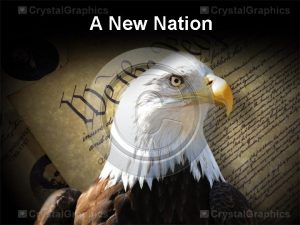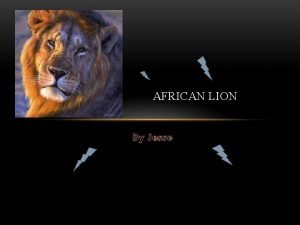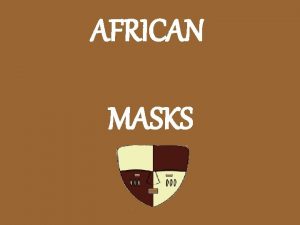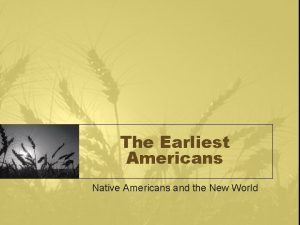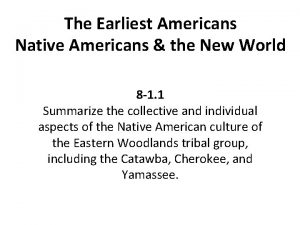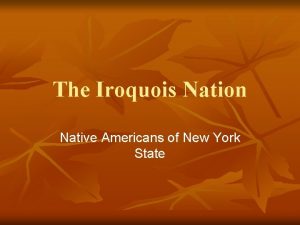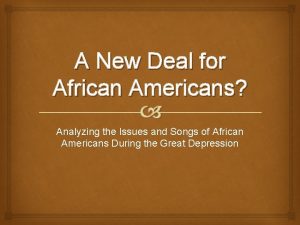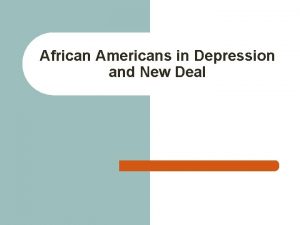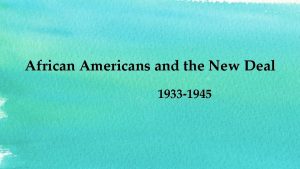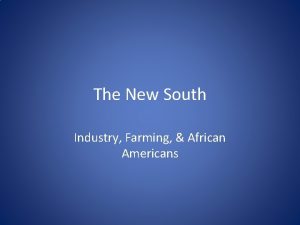Chapter 5 African Americans in the New Nation



































- Slides: 35

Chapter 5 African Americans in the New Nation 1783 -1820

I. Forces for Freedom n Economic change – Wage labor n Evangelical Christianity – Great Awakening n Revolutionary ethos – Natural rights doctrines n African Americans sought freedom – Escaped, purchased, sued, and petitioned for it

Escaping to the North Thousands of African Americans won their own freedom by escaping to the North before the Civil War.

Northern Emancipation n New England – Slavery collapsed quickly • African Americans refused to remain in bondage • Most white people acquiesced – Massachusetts » African men who paid taxes could vote, 1783 » Elizabeth Freeman » See PROFILE

Northern Emancipation (cont. ) n Mid-Atlantic states – New Jersey, New York, and Pennsylvania • Investment in slaves greater than in New England • Pennsylvania approved gradual emancipation, 1780 • New York, 1799

Slave Populations in the Mid. Atlantic States, 1790– 1860

Pepper-Pot, a Scene in the Philadelphia Market The title of this 1811 painting by German. American artist John Lewis Krimmel is Pepper. Pot, a Scene in the Philadelphia Market. Slavery still existed in Pennsylvania when Krimmel recorded this scene. It is likely, however, that the black woman who is selling pepper-pot (a type of stew) was free. Source: Philadelphia Museum of Art: Gift of Mr. and Mrs. Edward B. Leisenring, Jr. in honor of the 125 th anniversary of the museum, 2001. Sumpter Priddy III, Inc.

The Abolition of Slavery in the North

Emancipation and Slavery in the Early Republic Map 5– 1. Emancipation and Slavery in the Early Republic This map indicates the abolition policies adopted by the states of the Northeast between 1777 and 1804, the antislavery impact of the Northwest Ordinance of 1787, and the extent of slavery in the South during the early republic.

“Cuffe near him. . . grasps his hand. ” This engraving originally appeared in Boston in 1793, with the caption, “Cuffe near him. . . grasps his hand. ” It suggests the progress African Americans had made in the North but also the contempt in which many white northerners held them. The object of the picture is to ridicule Massachusetts governor John Hancock for participating in a black celebration.

The Northwest Ordinance, 1787 – Orderly sale of land – Support for education – Territorial government – New states – Banned slavery • South of Ohio River open to slavery • Set a precedent for excluding slaves from territory

The Louisiana Purchase and the Lower Mississippi Valley n People of African descent a majority – Two groups • Creoles – Craftsman and shopkeepers in New Orleans and port cities • Plantation slaves – Most directly from Africa – Americans settle in lower Mississippi Valley » Strict enforcement of slave codes » Expansion of slave code

Antislavery Societies in the North and the Upper South n Anthony Benezet – First antislavery society in the world, 1775 • Similar societies – Delaware, Maryland, Kentucky and Tennessee » Never appeared in Deep South – Generally cooperated in a loose framework, 1794 -1832 – Quaker dominated – Gradual emancipation – Upper South » Small and short lived

Manumission and Self-Purchase n Liberalized laws after the Revolution • Most southern states – Free individuals by deed or will – Virginia repealed ban on private manumissions, 1782 » Hundreds of slave holders in Upper South freed slaves » Religious sentiment and natural rights principles • Self-purchase agreements – Masters make a profit • Unprofitable investments – Changing crops – Old age – To avoid immediate escape

The Emergence of a Free Black Class in the South n Free black class grew in Upper South – Manumissions, self-purchase, and freedom suits – Maryland Virginia had the largest population n Deep South – Much smaller group • • Generally the illegitimate children of slave holders Favorites Unable to work North Carolina made manumissions more difficult after 1777

II. Forces for Slavery n North – Slavery was weak, little opposition to abolition n South – Slavery was strong and important to economy • Thrived and expanded

Distribution of the Southern Slave Population, 1800– 1860. Figure 5– 1. Distribution of the Southern Slave Population, 1800– 1860. The demand for slaves in the cotton-growing deep South produced a major shift in the distribution of the slave population.

The United States Constitution n Slaveholder concessions – To create a more powerful central government • Clauses designed to maintain slavery in the South – Continuing the Atlantic slave trade for twenty years – Returning escaped slaves to masters – Three-Fifths Compromise » Enhanced representation for slaveholders » Congress » Electoral college » Election of 1800

Cotton n Increased cultivation – Britain – Eli Whitney n Declining revolutionary fervor – Retreat from egalitarianism after 1790 s n Intensified white racism – Scientific racism justified slavery – Naturalization laws

III. Free Black Communities n Dynamic communities – North and Upper South • Philadelphia, Baltimore, New York, and Boston • Established distinctive institutions – To avoid inferior status in white-dominated organizations – Preserve African heritage • Mutual aid societies – Christian moral character – Generally restricted to men » Black freemasons » Prince Hall

Prince Hall This late-eighteenth-century portrait of Prince Hall (1735? – 1807) dressed as a gentleman places him among masonic symbols. A former slave, a skilled craftsman and entrepreneur, an abolitionist, and an advocate of black education, Hall is best remembered as the founder of the African Lodge of North America, popularly known as the Prince Hall Masons.

Origins of Independent Black Churches n Biracial churches – Never embraced African Americans as equals • Subordinate churches n Independent churches – Philadelphia between 1780 s and early 1800 s • St. George’s Methodist Church • St. Thomas’s Episcopal Church • African Methodist Episcopal (AME) Church – Richard Allen, see VOICES – Absalom Jones – Benjamin Rush

Philadelphia’s Bethel African Methodist Episcopal Church This drawing portrays Philadelphia’s Bethel African Methodist Episcopal Church as it appeared in 1829. It had been built in 1793 under the direction of Richard Allen, the first bishop of the AME denomination, and had been “rebuilt” in 1803.

The First Black Schools n Early 1700 s – Slave and free children – North and South – Ran by white clergy n After Revolution – Black people established schools for black children • • Mutual aid societies and churches created and sustained Prince Hall Brown Fellowship Christopher Mc. Pherson – Produced a growing class of literate African Americans

IV. Black Leaders and Choices n Educated black elite provided leadership – Richard Allen – Absalom Jones • See VOICES – James Forten • See PROFILE – Prince Hall

Migration n Prince Hall – Petitioned Massachusetts legislature to support colony n Paul Cuffe and colonization – End the Atlantic slave trade – Spread Christianity – Refuge for free black people – Make profits

Raphaelle Peale, the son of famous Philadelphia portraitist Charles Wilson Peale, completed this oil portrait of the Reverend Absalom Jones (1746– 1818) in 1810. Reverend Jones is shown in his ecclesiastical robes holding a Bible in his hand.

Slave Uprisings n Legacy of fear and hope – Gabriel, 1800 • American and French Revolution influenced • Natural human rights – Charles Deslondes, 1811 n Frightened white southerners n Raised hope for freedom among slaves

Toussaint Louverture (1744– 1803) led the black rebellion in the French colony of St. Domingue on the Caribbean island of Hispaniola that led to the creation of the independent black republic of Haiti in 1804. Louverture became an inspiration for black rebels in the United States.

The White Southern Response n Legacy of slave uprisings – Deepened reactions against egalitarianism • Feared race war that emancipation would cause • Southern states tightened control of black population – – – Outlawed assemblies Placed curfew on slaves and free blacks Made manumissions more difficult Revived slave patrols Became suspicious of outsiders Forcing free black people out of southern states

V. The War of 1812 n White prejudice and fear of black revolts – Militia Act of 1792 • Eliminated armed black participation in state militias • Navy ended black service on warships, 1798 • Southern states refused to enlist blacks in 1812 – Concerned black men with guns would aid slave revolt – “Black Brigade” – Lake Erie, September 1813 – Battle of New Orleans, January 1815

The Battle of Put-in Bay, fought on Lake Erie in September 1813, was a notable American victory during the War of 1812. This postcard suggests the prevelance of black sailors among American commander Oliver Hazard Perry’s crew.

VI. The Missouri Compromise n “A fire bell in the night” n Missouri applies for statehood, 1819 – Eleven free and eleven slave states • Tallmadge Amendment – Proposed gradual emancipation – African-American crowd galleries to hear debates – Southern threats of secession n Compromise – Henry Clay • Missouri, Maine, and 36 -30

The Missouri Compromise of 1820 Under the Missouri Compromise, Missouri entered the Union as a slave state, Maine entered as a free state, and Congress banned slavery in the huge unorganized portion of the old Louisiana Territory north of the 36° 30´ line of latitude.

VII. Conclusion n Waning egalitarian commitment and rising racism – Doomed earlier promises of freedom n Free black communities grew – Laid a foundation for • Education • Spiritual growth • Economic development n Forces for slavery grew stronger – Permanent black bondage
 Chapter 5 african american in the new nation
Chapter 5 african american in the new nation First african nation to gain independence
First african nation to gain independence Nation state vs nation
Nation state vs nation Nation vs state
Nation vs state State vs nation
State vs nation Chapter 2 section 4 launching the new nation
Chapter 2 section 4 launching the new nation Gettysburg
Gettysburg Chapter 19 section 4 wilson fights for peace
Chapter 19 section 4 wilson fights for peace Chapter 18 america claims an empire
Chapter 18 america claims an empire The americans chapter 15
The americans chapter 15 The americans chapter 10
The americans chapter 10 Chapter 28 section 2 the new frontier
Chapter 28 section 2 the new frontier The americans chapter 10
The americans chapter 10 Growing pains for the new nation
Growing pains for the new nation Creating a new nation
Creating a new nation The new nation faces challenges
The new nation faces challenges Growing pains for the new nation
Growing pains for the new nation Chapter 16 toward a new heaven and a new earth
Chapter 16 toward a new heaven and a new earth Lesson 5 african american culture and politics
Lesson 5 african american culture and politics Hình ảnh bộ gõ cơ thể búng tay
Hình ảnh bộ gõ cơ thể búng tay Bổ thể
Bổ thể Tỉ lệ cơ thể trẻ em
Tỉ lệ cơ thể trẻ em Voi kéo gỗ như thế nào
Voi kéo gỗ như thế nào Thang điểm glasgow
Thang điểm glasgow Hát lên người ơi
Hát lên người ơi Các môn thể thao bắt đầu bằng tiếng nhảy
Các môn thể thao bắt đầu bằng tiếng nhảy Thế nào là hệ số cao nhất
Thế nào là hệ số cao nhất Các châu lục và đại dương trên thế giới
Các châu lục và đại dương trên thế giới Công thức tính độ biến thiên đông lượng
Công thức tính độ biến thiên đông lượng Trời xanh đây là của chúng ta thể thơ
Trời xanh đây là của chúng ta thể thơ Mật thư anh em như thể tay chân
Mật thư anh em như thể tay chân 101012 bằng
101012 bằng Phản ứng thế ankan
Phản ứng thế ankan Các châu lục và đại dương trên thế giới
Các châu lục và đại dương trên thế giới Thơ thất ngôn tứ tuyệt đường luật
Thơ thất ngôn tứ tuyệt đường luật
